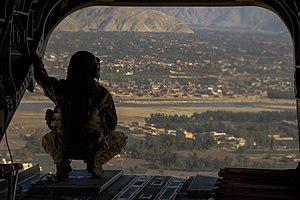Operation Freedom's Sentinel
| Operation Freedom's Sentinel | |||||||
|---|---|---|---|---|---|---|---|
| Part of the Global War on Terrorism, War in Afghanistan, Resolute Support Mission | |||||||
 A U.S. Army crew chief with 17th Cavalry Regiment surveys the area over Jalalabad, Afghanistan. | |||||||
| |||||||
| Belligerents | |||||||
|
|
| ||||||
| Commanders and leaders | |||||||
|
| ||||||
| Strength | |||||||
|
| Unknown | ||||||
| Casualties and losses | |||||||
|
| 60,000+ | ||||||
Operation Freedom's Sentinel (OFS) is the official name used by the U.S. Government for the mission succeeding Operation Enduring Freedom (OEF) in continuation of the Global War on Terrorism. Operation Freedom's Sentinel is part of the NATO-led Resolute Support Mission, which began on January 1, 2015. OFS has two components: counterterrorism and working with allies as part of Resolute Support.[3] There are 16,551 NATO troops in Afghanistan as of June 2020.[4] There are 306,807 Afghan National Defense and Security Forces (self-reported) as of January 2020.[5]
Objectives
After thirteen years of Operation Enduring Freedom, the U.S. military and NATO allies shifted focus from major military operations to a smaller role of NATO-led training and assistance.[6] While the bulk of the new mission was under the NATO-led Resolute Support Mission (RS), "a separate 'non-NATO' contingent of U.S. forces will participate in force protection, logistical support and counterterrorism activities."[6]
An October 1, 2015, statement by Gen. John F. Campbell, commander, Resolute Support Mission, U.S. Forces-Afghanistan/ISAF, defined the U.S. military's objectives. "U.S. forces are now carrying out two well-defined missions: a Counter-Terrorism (CT) mission against the remnants of Al-Qaeda and the Resolute Support TAA mission in support of Afghan security forces. Our CT and TAA efforts are concurrent and complementary. While we continue to attack the remnants of Al-Qaeda, we are also building the ANDSF so that they can secure the Afghan people, win the peace, and contribute to stability throughout the region."[7]
When OFS started U.S. troop levels in Afghanistan were at 9,800 troops. General Campbell requested an additional 1,000 troops while NATO troop levels were built up to a force of about 13,500. His request was granted.[8] As of 2019, U.S. troop levels are at 14,000 troops in combined support of NATO RS missions and OFS.[9]
Congressional reports
The Lead Inspector General for Overseas Contingency Operations (Lead IG) is responsible for submitting a quarterly report on OFS to Congress. The quarterly report describes activities in support of OFS, as well as the work of the Department of Defense, the Department of State, and the United States Agency for International Development to promote the U.S. Government’s policy goals in Afghanistan,[10]
Excerpts from the January 1, 2018 - March 30, 2018 report:
General John Nicholson, Jr., Commander of Resolute Support and Commander of U.S. Forces-Afghanistan (USFOR-A) said this quarter that U.S. and Afghan forces were gaining momentum through the new South Asia strategy, and that the Taliban was shifting to "guerilla tactics and suicide attacks" because it was no longer able to carry out attacks to seize cities or districts. However, suicide attacks and bombings in Kabul and across Afghanistan resulted in hundreds of civilian casualties, and raised concerns among Afghans about whether the government can secure the country.[10]
The United States faces multiple challenges in Afghanistan. Previous Lead IG quarterly reports identified several challenges facing Afghanistan and the OFS mission, including preparing to hold safe, credible parliamentary elections, defeating ISIS-K, and pressuring Pakistan to eliminate safe havens. During the quarter, the United States and Afghanistan continued to seek to address these challenges, though with limited progress, as detailed throughout this report.[10]
This quarter, Lead IG agencies also observed the following emerging challenges that complicate the OFS mission and efforts to end the conflict:
Stemming the Attacks in Kabul
Managing Increased Violence in Afghanistan
Pursuing Peace[10]
In August 2019 soldiers of 3rd Brigade Combat Team, 82nd Airborne Division were deployed to Afghanistan to replace the 48th Infantry Brigade Combat Team, 3rd Infantry Division. In February 2020 soldiers from the 1st Brigade Combat Team, Tenth Mountain Division were deployed to Afghanistan to replace the 3rd Brigade Combat Team, 82nd Airborne Division in and around Helmand Province, Afghanistan and the Gandhara Zone of Northwest Pakistan and Southwest Afghanistan.
References
- ^ "'Probably the largest' al-Qaeda training camp ever destroyed in Afghanistan". the Washington post. October 30, 2015.
- ^ "ICCT-Reed-Al-Qaeda-in-the-Indian-Subcontinent-May2016.pdf" (PDF). International Centre for Counter-Terrorism – The Hague. May 2016.
- ^ "Meet Operation Freedom's Sentinel, the Pentagon's new mission in Afghanistan". Washington Post. Retrieved 2018-10-07.
- ^ "Resolute Support Mission (RSM): Key Facts and Figures" (PDF).
{{cite web}}: CS1 maint: url-status (link) - ^ "SIGAR Quarterly Report April 30, 2020" (PDF).
{{cite web}}: CS1 maint: url-status (link) - ^ a b "NATO combat mission formally ends in Afghanistan". Washington Post. Retrieved 2018-10-07.
- ^ "Operation Freedom's Sentinel and our continued security investment in Afghanistan". www.army.mil. Retrieved 2018-10-07.
- ^ Sisk, Richard. "Amid Confusion, DoD Names New Mission 'Operation Freedom's Sentinel'". Military.com. Retrieved 2018-10-07.
- ^ "Operation Freedom's Sentinel: Lead Inspector General Report to the United States Congress, April 1, 2019–June 30, 2019" (PDF). Department of Defense Office of the Inspector General. 20 August 2019. p. 47. Retrieved 12 October 2019.
- ^ a b c d "OPERATION FREEDOM'S SENTINEL REPORT TO THE UNITED STATES CONGRESS JANUARY 1, 2018‒MARCH 31, 2018" (PDF).
